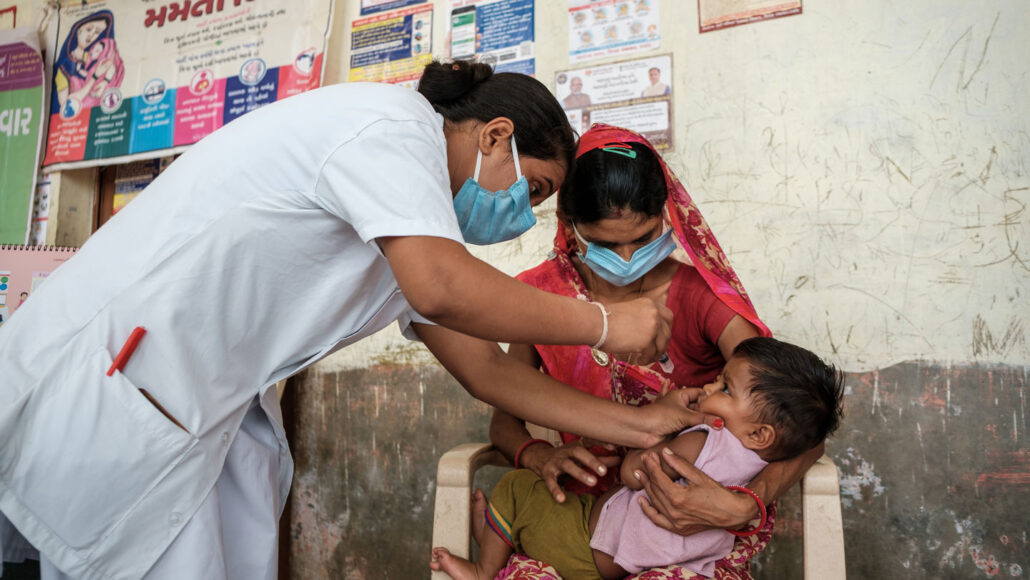Millions of kids have missed routine vaccines thanks to COVID-19
The missed shots could leave kids vulnerable to measles, diphtheria, tetanus and pertussis

In June 2020, after a COVID-19 lockdown was lifted, a 4-month-old baby gets a routine vaccination against rota virus, here, at a clinic in the Indian state of Gujarat. Childhood vaccinations against measles, diphtheria, tuberculosis and pertussis also have dropped dramatically during the pandemic, new data show.
© UNICEF/UNI341113/Vinay Panjwani
The COVID-19 pandemic has forced millions of children around the world to miss out on important vaccines, new research suggests. That ups the risk of dangerous outbreaks of infectious diseases. Measles, which can make kids very sick, is among them.
As the coronavirus has spread, many people have missed out on important medical care. That includes kids. An estimated 9 million more children than expected didn’t get a first dose of the measles vaccine in 2020. That’s according to a July 14 modelling study in the Lancet. Another 8.5 million children are projected to have missed a third dose of the so-called DTP shot. It offers protection against diphtheria, tetanus and pertussis (or whooping cough).
The news isn’t that surprising. Last year, the World Health Organization, or WHO, and other public health agencies issued a warning. They cautioned that the COVID-19 pandemic might lead some kids to miss out on routine childhood vaccines. Those missing shots could put vulnerable children at risk. And they now would be most at risk during outbreaks of highly contagious diseases.
“We’ve lost over 4 million people to COVID,” says Suzette Oyeku. She is a pediatrician in New York City. She works at the Children’s Hospital at Montefiore and Albert Einstein College of Medicine. “How many additional lives do we want to lose for not protecting people against stuff that we know we can protect?”
Some uncertainty
There is some uncertainty in the new Lancet study’s estimates. The actual numbers for some regions could be lower or higher. That’s because vaccine data weren’t available for all countries, says Kate Causey. She is a global health researcher. She works at the University of Washington’s Institute for Health Metrics and Evaluation in Seattle.
A separate analysis from WHO was described in a July 14 press release. It does show lower numbers. However, millions of children are still missing crucial vaccines.
At least 3.5 million more children in 2020 missed their first DTP dose than in 2019, the WHO reports. Three million more kids in 2020 also missed their first measles vaccine, compared to 2019. Many children in Southeast Asia, for example, missed their shots. The problem was worst in India, according to the WHO. There, more than an estimated 3 million children didn’t get a first dose of the DTP vaccine in 2020. That’s at least twice as many as in 2019.
Missing shots
Causey was part of a team that estimated global vaccinations in 2020 against measles and DPT. They analyzed public health data as well as mobility patterns. Without the pandemic, some 83.3 percent of children would have received the DPT vaccine. The researchers’ models also suggest that 85.9 percent would have gotten the measles vaccine in 2020.
Instead, they report in their Lancet study, only about 76.7 percent of kids received the DTP vaccine. That’s the lowest rate since 2008. And it means 30 million kids — 8.5 million more than expected — missed the shot. Only about 78.9 percent were vaccinated against measles. That means 27.2 million children, or 8.9 million more than expected, missed their shots. Experts haven’t seen a level of measles vaccination in kids that low since 2006.
Missing doses
The World Health Organization and UNICEF tallied the number of children in countries around the world who missed their first dose of a combined vaccine for diphtheria, tetanus and pertussis, or DTP, in 2019 compared with 2020. These 11 nations had the highest increases in those missed shots.
Countries with the greatest increases in children not receiving a DTP vaccine dose
| Country | 2019 | 2020 |
| India | 1,403,000 | 3,038,000 |
| Pakistan | 567,000 | 968,000 |
| Indonesia | 472,000 | 797,000 |
| Philippines | 450,000 | 557,000 |
| Mexico | 348,000 | 454,000 |
| Mozambique | 97,000 | 186,000 |
| Angola | 399,000 | 482,000 |
| Tanzania | 183,000 | 249,000 |
| Argentina | 97,000 | 156,000 |
| Venezuela | 75,000 | 134,000 |
| Mali | 136,000 | 193,000 |
That estimated decline is troubling. The ongoing COVID-19 pandemic makes it even more so, Oyeku says. There’s a “concern that we’re going to start to see clusters of outbreaks of vaccine-preventable disease.” There may also be outbreaks of COVID-19 in kids at the same time. That could cause even worse problems.
Regions like South Asia had the largest decline in vaccinations, the WHO analysis shows. DTP shots in kids dropped nearly 60 percent below what was expected, that research suggests. Measles doses dropped by 40 percent in that region. Sub-Saharan Africa had the smallest decline — only some 4 percent for either shot.
High-income countries including the United States saw an estimated 6 percent drop in kids getting DTP shots. They also saw an 8 percent drop for measles, the team found. A separate study was released in the June 11 Morbidity and Mortality Weekly Report. It focused on the United States. Rates for these shots dropped across 10 states, it reports. That study compared March to September 2020 with the same period in 2018 and 2019. The states include Idaho, Iowa and Washington.







